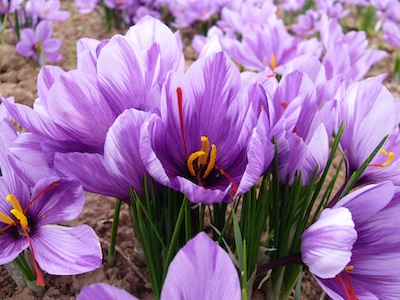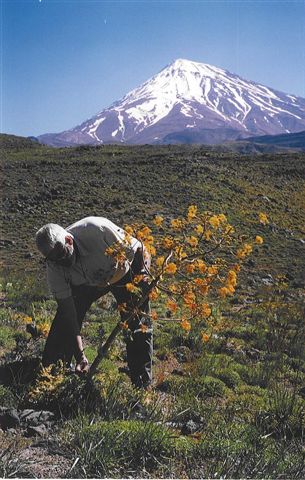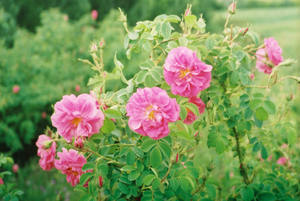The majority of medicinal plants are sold with next to no documentation in regards to cultivation place, year, conditions etc. Traceability of herbal raw materials has become an important issue in the EU regulations aimed on consumer protection. Producers of food products including supplements - and by analogy also of herbal medicinal products - must be able to trace their raw materials down to the origin of the plant. The current practice of trading does, however, rarely allow for such transparency.
 Eusano secures the total traceability of the commercial supply routes in raw material trading, thereby avoiding adulterations. At the same time the quality standards can be improved by the selection of a specific chemotype.
Eusano secures the total traceability of the commercial supply routes in raw material trading, thereby avoiding adulterations. At the same time the quality standards can be improved by the selection of a specific chemotype.
- Programs for screening of local habitats and identification of high performance cultivars
- Transfer of the identified plant types either to cultivation or, where this is not possible, to closely controlled collection
- Development of proper cultivation, harvesting and processing techniques
- Transfer of technology of cultivation or collection techniques to local farmers
Traceability of herbal raw material
The quality of herbal raw material starts in the field. Unfortunately the information regarding the origin of natural compounds is often lost in the complex trading channels. E.g., Spanish saffron (Crocus sativus) is more often than not a product from the Middle East, "Siberian ginseng" (Eleutherococcus senticosus) comes from China or Korea, and the South African plant Hoodia gordonii is often collected from the species Opuntia ficus-indica in Mexico, which is, however, devoid of active constituents.
As defined in the EU directive 178/2002/EC producers of food – and thus also of food supplements – are obliged to ensure the traceability of the origin of herbal raw materials. The directive is based on the WHO-Guideline "Good Agricultural and Collection Practice”, which defines clear rules for the treatment of raw materials of herbal origin.
In an analogous way the very same rules also apply to the registration of herbal medicinal products. Exact details regarding geographic origin, cultivation and harvesting methods as well as drying, storage and transport conditions must be included in registration dossiers in CTD format.
The EU directives provide a chance for better positioning in the areas of quality, safety, protection of the environment and social engagement in developing countries for Eusano's customers.
Avoiding adulterations
 Adulterations are a consequence of obscure commercial supply routes, especially when the herbal substance is either very rare or very expensive.
Adulterations are a consequence of obscure commercial supply routes, especially when the herbal substance is either very rare or very expensive.
Saffron (Crocus sativus) is one of the most expensive spices worldwide. Correspondingly, the number of saffron adulterations is rather high. With saffron originating exclusively from cultivation, projects aimed at securing
quality and traceability of various cultivars of saffron are the obvious solution.
Galbanum, a resin of Ferula gummosa mainly used in cosmetics, but also known for its medicinal virtues, is frequently adulterated with resins from Dorema ammoniacum or Ferula asa-foetida. Galbanum originates exclusively from wild crafting. We organised a project of controlled collection under conditions securing the survival of the plant as well as the purity of the raw material.
 Rose water from Damascene rose (Rosa damascena) neither originates from Damascus, nor - frequently - from roses. The true origin of Damascene rose is Persia. Rose water is frequently prepared by mixing water with synthetic aromatic compounds. Likewise, inferior rose oil is often "enhanced" by various synthetic or natural additives. Eusano provides authentic and high quality rose water and rose oil in high quantities - with full traceability.
Rose water from Damascene rose (Rosa damascena) neither originates from Damascus, nor - frequently - from roses. The true origin of Damascene rose is Persia. Rose water is frequently prepared by mixing water with synthetic aromatic compounds. Likewise, inferior rose oil is often "enhanced" by various synthetic or natural additives. Eusano provides authentic and high quality rose water and rose oil in high quantities - with full traceability.
Projects aimed at securing traceability of herbal raw material not only provides an opportunity to optimise the quality of the raw material, but also a chance to ensure the absence of typical adulterants in the commercial channels.
Cultivation and controlled collection
Origin and quality of the herbal raw material can be guaranteed in projects oriented at the WHO guideline "Good Agricultural and Collection Practice". According to the specific needs this can be reached through projects of controlled cultivation, or otherwise controlled collection. Both practices secure the quality of herbal raw material, help to avoid accidental adulterations, and stop fraudulent adulterations in the trading channels.


